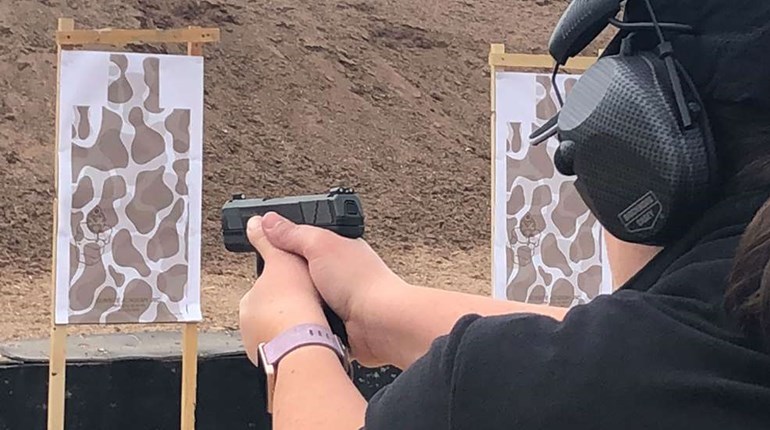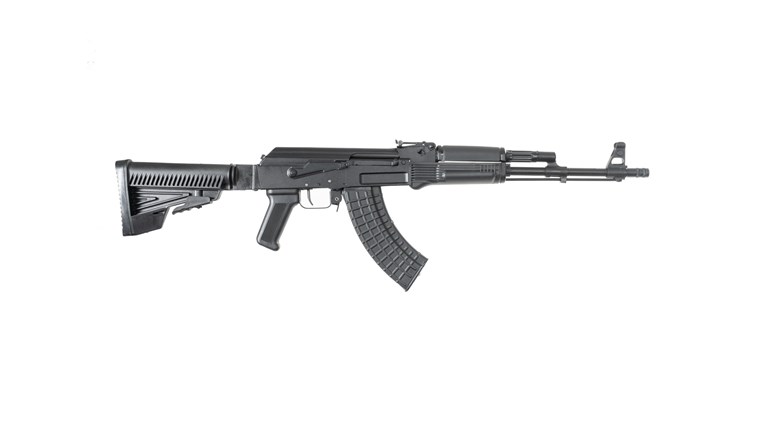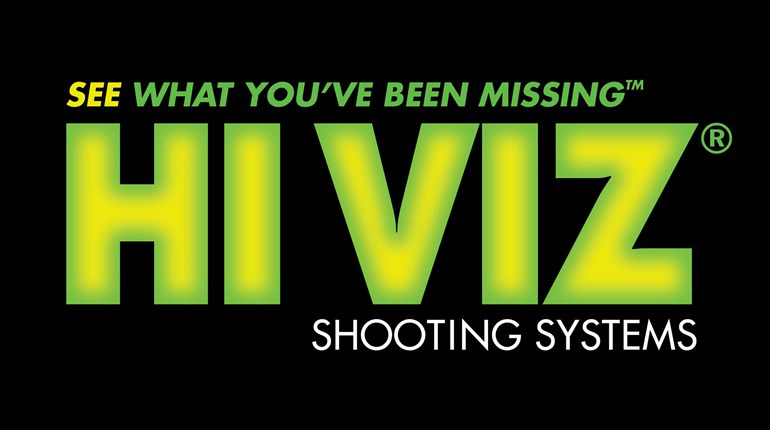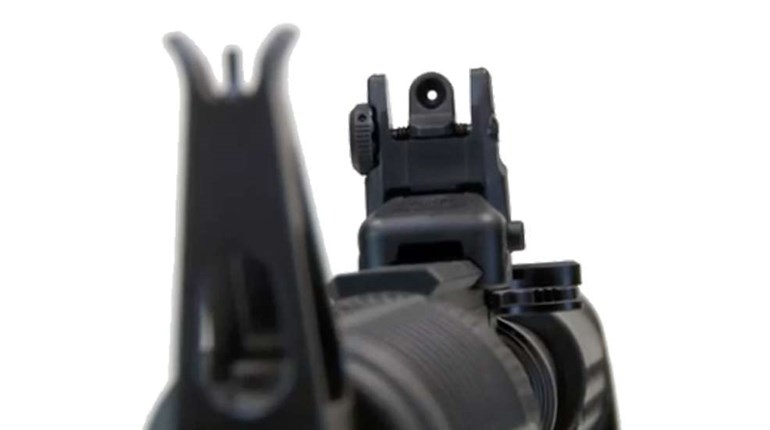
Watch your #$%& front sight! Anyone who has spent much time on a shooting range has likely had this little gem hurled at them. What the heck is the sight supposed to be doing anyway? What do you do if you just can’t see it? Is that why you keep missing, or is it something else? Options for and opinions about handgun sights abound, but will any of them actually improve your shooting?
What are Sights?
I teach gunsmithing for a living, and I sometimes ask my students a seemingly simple question: What are sights? The answers are very interesting. Usually something like: “Sights are a way to point the bang stick at the thing that you want to shoot.” While technically correct, I try to prod them toward a more specific definition. Simply, sights are a reference point. More specifically, they are a measuring device. The sighting system provides a measurement and visual verification of the angular and radial position of your firearm’s bore relative to the target. This definition applies to any type of firearm, from a shotgun swung at a flying clay target, to a rifle aimed at something a mile away. This assumes that the sights are appropriately aligned with the bore of the firearm or “sighted in.”
Intended Purpose of the Firearm
Since we already discussed the idea of sights being a measuring tool, let’s stay with that description. The more precise the measuring device, the slower and more cumbersome it is to use, like a measuring tape versus a micrometer. For larger targets that need to be engaged at a higher speed, less precise but more visible sights are of greater utility. This compromise should be kept in mind. For instance, a Smith & Wesson J-frame revolver would be utterly useless mounted underneath a 36X target scope and a .338 Lapua rifle couldn’t be fired accurately with a shotgun bead. Regardless of what Tactical Tim at your local range says, your concealed-carry pistol, Steel Challenge blaster and hunting revolver don’t necessarily require the same type of sights.
Historical Context
Most handguns from a century ago had small, crude sights that weren’t adjusted easily. The original GI 1911 sights are a good example. Most people didn’t consider handguns to be precision-shooting instruments, but rather a short-range weapon of last resort. Even many law enforcement officers were trained in unsighted “point shooting.” While more the exception than the rule, specialized target models were manufactured that had quite serviceable sights. Top shooters of the day were capable of very accurate shooting by any standard.
In the years after World War II, there were many veterans who had experience in both combat and target shooting with handguns. They began installing better sights on their defensive handguns that allowed more precise shooting. These shooters also evolved handgun-shooting techniques that led to people being more proficient at sighted fire. For law enforcement and defensive shooting, emphasis was placed on being able to accurately hit targets quickly. Shooting the bad guy before he can shoot you is the essence of tactical shooting. This blend of tactical and target shooting led to the birth of shooting competitions such as USPSA and IDPA, which further emphasized accuracy and speed. Today’s shooters are blessed (or maybe cursed) with myriad sight options that purport to offer faster acquisition and better accuracy.

Sight Alignment and Picture
Traditional iron sights are meant to be used by aligning the post front with a notch cutout in the rear sight. The tops of the front and rear sights should be level with each other and there should be an equal amount of daylight on either side of the front sight. The relationship of the sights to each other is known as sight alignment. Adding a target to the mix turns sight alignment into a sight picture.

You may have been taught (as I was), that the correct way to use iron sights is to keep the front sight, rear sight and target all in sharp focus while aiming. Unfortunately, this is an optical impossibility. The human eye can only focus on one plane at a time. When we are young, our eyes can switch planes fast enough to fool us into thinking we can focus on multiple. As adults, we must accept reality. The good news is that we can choose upon which plane to focus. Traditional target-shooting instruction dictates the front sight should be in sharp focus, while the rear sight and target can be somewhat fuzzy. For targets that require a high degree of precision, this is true. Since the job of the sights is to verify where the gun is pointed, a less precise measurement is necessary for a larger, closer target. In an extreme case, focusing on the target and superimposing the top of the pistol in front of it might be enough to ensure a hit. This is still a sight picture of sorts, much like the way a shotgun shooter focuses on the target and only sees the bead peripherally. For a great number of handgun targets, some compromise of sight and target focus is acceptable. This shouldn’t be confused with unsighted point shooting. Brian Enos describes this concept in great detail in his legendary book “Practical Shooting: Beyond Fundamentals.”

Fixed or Adjustable
One of the first big choices facing a shooter is whether to choose a fixed or adjustable rear sight. The standard line is that fixed sights are more rugged and less prone to breakage, while adjustable sights offer greater flexibility. Good steel (not plastic factory Glock) fixed sights like the typical Novak- or Heinie-style offerings are certainly robust. While the potential for breakage exists, I like the ability to readily adjust my sights to accommodate different conditions or ammunition and prefer adjustable sights for most applications. If that choice isn’t available or practical, I don’t have much heartburn with good quality fixed sights.

Blade and Notch Width
The width of the front sight and rear sight notch are important and deserve some thought. If a front sight is centered in a rear notch, angular aiming error can be measured more accurately if there is less space on each side of the front sight. However, a tightly matched front post to rear notch will usually be slower to align. Front-sight widths vary from .093 wide to around .140, with corresponding rear notches from .120 to .150. I tend to prefer front sights around .105 to .110 wide for my competition and general shooting pistols. For my carry handguns, usually something more like .125 to .135 with a tritium insert. Shooters tend to worry that a wide front sight will cover too much of the target, but is usually much less of an issue than they perceive.

Sight Visibility
Sights aren’t much good if you can’t see them. Shiny stainless steel front sights supplied on some factory revolvers are essentially invisible in bright light. Plain-black sights are great in ideal lighting conditions and with light-colored targets, but reality is usually less than ideal. We look for ways to make sights more visible, especially as our eyes age. There are several strategies. The shape of the front-sight blade is a good starting point. The closer to vertical (or even undercut) the blade is, the less light it will reflect. This means that it will be “blacker” in bright light. The trade-off is that they tend to snag on things more easily. Adding serrations to either a front or rear sight helps to further reduce reflectiveness, but may cause the sight to appear slightly “fuzzier.” The front sight should command more of your attention than the rear, so it is common to want something to make it more prominent. Bright-colored inserts or even painting the front sight are popular. In my opinion, most of these sights are hard to use because the edges of the blade can’t be defined clearly, there is just a gob of bright color out there. Having a black front sight with a colored dot, line or shape cut into it are common options, and some work very well. I am particularly fond of a vertical white stripe up the center of the front-sight blade, provided the edges of the sight are still black. The three white-dot arrangement is quite common on factory pistols, but is rarely found on those belonging to experienced shooters. Front sights with fiber-optic inserts are also popular with competitive shooters, and rightly so. They offer a bright dot to assist in sight acquisition, while still offering crisp edges to allow for precise aiming. The size and color of the fiber insert varies. I tend to use a small .040-diameter green insert most often. I am in the minority here, as most shooters tend to opt for larger red inserts. A fiber-optic front sight paired with a black rear is the standard for most competitive action- shooting disciplines.
If shooting in low light is anticipated, tritium sights are standard. These are available in various sizes and patterns, though green tritium in a three-dot arrangement is the most common. I’ve experimented with patterns, but have never found what I consider to be the perfect low-light sight solution, though a weapon-mounted light helps immensely. My carry guns usually sport the typical three-dot tritium configuration. The Heinie “Straight 8”-style with two dots meant to be stacked vertically are also quite usable.

Other Types of Sights
Intentionally omitting red-dot sights and other optics, which are a different subject entirely, there are many sight arrangements on the market which don’t fit the mold of notch and post sights. These are usually advertised to be faster or more intuitive. They run the gamut from a gutter slot milled into the top of a slide, a row of superimposed chevrons or triangles to align, to rear aperture sights on pistols. The XS Big Dot express sight is a notable example. This sight harkens to express sights on dangerous-game rifles. The idea is that stacking the big dot into a shallow V is faster than a notch/post, and still allows acceptable accuracy. I have installed a lot of these and cannot say that I am a fan. I tend to shoot more accurately with them than I expect, but I don’t find them faster to use. While I applaud the search for more effective sighting systems, I just don’t believe that I have seen a better non-optical sight arrangement yet. If something truly offered better speed and precision, competitive shooters would have all switched by now.
Corrected Vision
Having glasses or contacts obviously improves vision, but sometimes compounds sight visibility issues. This is especially true of bifocals. Lenses are usually meant to correct for either distant or close objects, and vision is often somewhat compromised at the other end of the spectrum. The common issue for folks older than 40 is that the sights get harder to see while the target is still visible. A good optometrist can help, but they need to understand exactly at what distance you want to focus. After getting permission from the good doctor, I took a pistol to my last appointment to measure the exact focal distance.
We all perceive sights differently. Our visual acuity and skill levels differ. Preferences and needs in sights change as we age. Sights that I don’t like today may be my absolute favorite in 15 years. I once had plain-black sights on all my handguns. Now I find myself needing something to make the front sight more visible. As with most other things in shooting and firearms, a bit of experimentation is always necessary to find what actually works for you. Don’t be afraid to make changes and adapt to what currently works best.
About the Author
In addition to being a lifelong firearm enthusiast, Mark Dye has been a professional gunsmith for 22 years. He graduated from Montgomery Community College’s Gunsmithing program in 1998 and also has formal training as a machinist. Dye worked as a pistolsmith at Clark Custom Guns in Louisiana for 4 years and at Bowen Classic Arms in Tennessee for 9. Additionally, he ran his own business, Dye Custom, while employed at Bowen Classic Arms. Dye has been a full-time gunsmithing instructor at Montgomery Community College since 2011 and has been the Program Director since 2015. Furthermore, he has a patent on a trigger system for 1911-style handguns that is currently being produced by Nighthawk Custom. Lastly, Dye is a Master class USPSA competitor and has been an avid competitive shooter in several disciplines for more than 20 years.






































